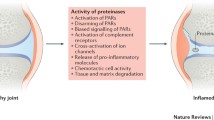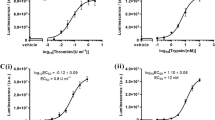Abstract.
Proteinase activated receptors (PARs) are a newly identified family of G-protein-coupled receptors that are activated by proteinases released into tissues during inflammation. Evidence has accumulated which shows that PARs can exhibit both anti- and pro-inflammatory properties in different organ systems. During arthritis, proteinases are known to be released into the joint where they orchestrate tissue remodelling and degeneration. By activating PARs, these proteinases have the potential to modulate joint inflammation and pain by a highly targeted and selective receptor pathway. The recent identification of PARs on synovial fibroblasts, neutrophils, macrophages and mast cells is further evidence that this intriguing family of receptors could play a role in the pathogenesis and symptoms of arthritis. This review article provides an overview of the current knowledge regarding PARs and their emerging role in arthritis.
Similar content being viewed by others
Author information
Authors and Affiliations
Corresponding author
Additional information
Received 30 April 2008; accepted by J. Di Battista 16 June 2008
Rights and permissions
About this article
Cite this article
Russell, F.A., McDougall, J.J. Proteinase activated receptor (PAR) involvement in mediating arthritis pain and inflammation. Inflamm. Res. 58, 119–126 (2009). https://doi.org/10.1007/s00011-009-8087-0
Published:
Issue Date:
DOI: https://doi.org/10.1007/s00011-009-8087-0




